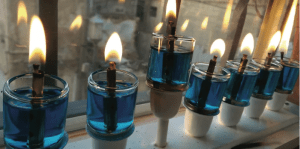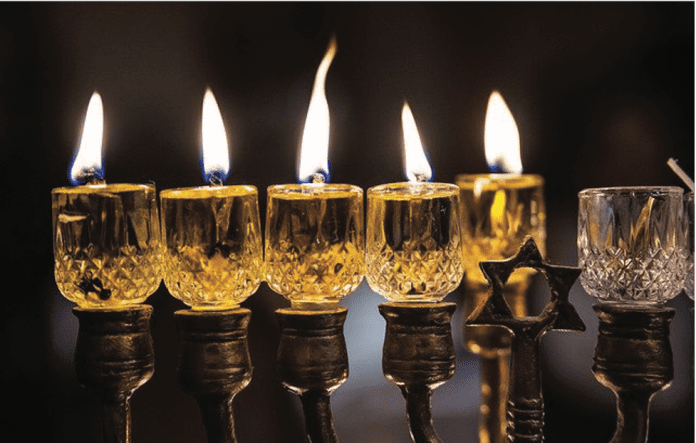Presented by Rabbi Hayim Asher Arking and Rabbi Ezra Ghodsi of Ohr Halacha
The misvah of menorah is an extremely beloved misvah (Rambam). In regard to all misvot, there is a standard way of performance and then an enhanced and more meticulous way. Being that Hanukah is so beloved, it has been unanimously accepted that the misvah is performed in a superior manner; that is we begin with a single candle on the first night, adding a candle each night, ultimately kindling eight lights in the final night. We hope that the following guide will enhance our superior performance.
When is the preferred time to light the menorah?
The proper time to light is close to nightfall, that is approximately twenty minutes after sunset (4:50pm in the NY/NJ area).1 The earlier on in the evening the better, so as to be within half hour of nightfall; otherwise, anytime thereafter while there are still passersby is fine. If no one will be home until very late, for example at 2am, when there are no people passing by, he may still light when he arrives at that late hour.2 He should try to have at least one other person up while he is lighting the menorah.3 If this is not an option he may light after plag hamincha, provided that there is enough oil to last half hour after nightfall.4
Can I eat before I light?
Once it reaches within a half hour of the time to light the menorah one should not sit down for a bread meal. However, if one already started his meal before that half hour, he may continue, though he can light during his meal.
Is it better for my wife to light on time before I come home, or wait until everyone is home?
Lighting on time is very important and one should not necessarily wait for the rest of the family; however this will depend on how late they will be home, if there will still be passersby, and who it is that we are waiting for. Today, we generally light the menorah indoors, therefore one can be more lenient to wait for the whole family up to a reasonable time that there will still be passersby.5
What if I lit Shabbat candles first?
Although one should first light the menorah and then light the Shabbat candles, if the wife mistakenly lit first, the husband may still light the menorah after the wife has lit the Shabbat candles. If the woman is the one lighting the menorah, and she lit the Shabbat candles first, lighting the menorah at this point will depend on if her custom is to accept Shabbat with the lighting of the candles or not.6
Where do I light?
The placement of the menorah is for public display of the miracles Hashem has done with us. Originally, the lighting would be outside, by the entrance to the courtyard or home. However, as we are in exile among other nations, it is recommended in most places to light inside and not incite our gentile neighbors. Although when lit inside, the menorah is primarily for the people inside the home, we light the menorah by the window so it is visible to the passersby.7
How high should I place my menorah?
The preferred height to place the fire of the candles is approximately between 10 inches and 32 inches high. The reason being that it should be noticeable that the light is for the purpose of Hanukah, and not to provide light for the household. For this reason, the menorah should be placed away from the place of the Shabbat candles. Should the menorah be visible only when placed on a higher window ledge, or if there are young children around, there is no problem with placing the menorah higher than the preferred height mentioned above.8
Who lights?
Unlike other misvot, like eating massah or shaking a lulav, where each person is required to perform the misvah individually, any one member ― man or woman over bar/bat misvah ― may light the menorah on behalf of the household. The reason why women are also obligated in this mitzvah, is because a woman played a significant role (Yehudit killed an important Greek general.)
Children under the age of bar/bat misvah may light any subsequent candles after the first candle is lit by an adult, providing that they have reached the age of chinuch, meaning that they have some understanding of the misvah.
Children younger than that may only light the shamosh candle.9
What should I do if I am a guest?
One may fulfill his obligation with his host. The guest should participate in the misvah by acquiring a partial ownership of the oil and wicks.10 For close family members visiting and sleeping over, the host is surely considering them to be included as part of the household, for regular guests however, it is preferable for the host to verbalize that he is giving the guest acquisition as a partial owner in the oil, wicks, etc.11
I have a child studying out of town in school, is he required to light himself?
Children who are still being supported by their parents and view their parents’ house as home, are still considered part of the household, even though they are temporarily not living in the house. Therefore, they can fulfill their obligation with their parents’ lighting. However, if one’s home is in America and he is in Israel, then at the time of lighting in Israel, no one can yet light in America. When it becomes nightfall in America it is usually past the time when there are passersby in the streets of Israel. Therefore, it is preferable for the student to light himself, and according to some, even with a beracha. If he would be in an earlier time zone, such as home in NY and studying in LA, then all hold he will not recite a beracha.12
How do I light?

Every Friday night in reading bameh madlikin, we recite a list of wicks and oils that are not suitable for Shabbat candles, either because they do not draw the oil well, causing flickering or because of their odor. For Hanukah, however, these wicks and oils may be used. The reason is that since the objective of Shabbat candles is to enjoy and benefit from their light, one may mistakenly adjust or tilt the candle for it to light better on Shabbat. However, Hanukah candles however, are not for our personal use and therefore, even if they do not light well, we have no concern that one may adjust the candles.13
Should I use candles or oil?
The miracle occurred through the flask of oil lasting eight days. Therefore, the preferred manner to perform this misvah is with oil; otherwise, candles are acceptable.14
Which side of the menorah do we start lighting from?
The setup of the candles is arranged so that on the first night the rightmost candle is on the right of the one lighting. On the second night, the second candle will be on the immediate left of the first candle. And so on ― every added candle is placed in the next left slot. The lighting will always begin with the newest added candle (increasingly left) so that when you actually light, your direction will bring you to move your hand toward the right. The reason to perform the lighting in a rightward direction is like all avodah ― service in the Bet Hamikdash where the setup of the service positions the Kohen to begin at a point where his direction during his avodah will subsequently turn toward the right.15
What if my candles went out?
It is proper to keep one’s hand lighting the flame until most of the wick is lit before proceeding to the next candle.16 Once the fire caught onto the wick properly, even if it went out within a half hour, one is not required to light again; however, it is preferable.17 The leftover oil or candle from it extinguishing prematurely can be used for the next night. Otherwise it will not be disposed of like regular garbage since it was dedicated for a misvah; therefore, it is burned, similar to leftover sacrifices.18
Can I light a match from my Hanukah candles?
If the lighting of the match is for the purpose of lighting another candle, the preferred way is to use the shamash candle to light a match or else to directly light from one wick/candle to the other. However, to light or relight the shamash or the lighting for any other purpose, one may not use the Hanukah candles.19
Coordinated by Pnina Souid



